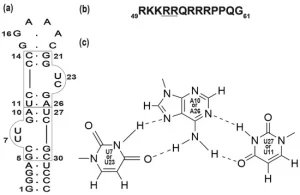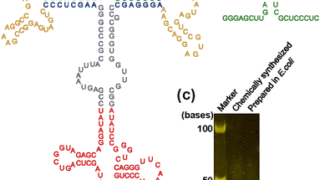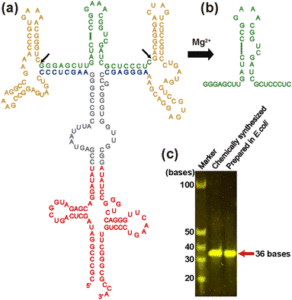Complex Formation of an RNA Aptamer with a Part of HIV-1 Tat through Induction of Base Triples in Living Human Cells Proven by In-Cell NMR

An RNA aptamer that strongly binds to a target molecule has the potential to be a nucleic acid drug inside living human cells. To investigate and improve this potential, it is critical to elucidate the structure and interaction of RNA aptamers inside living cells. We examined an RNA aptamer for HIV-1 Tat (TA), which had been found to trap Tat and repress its function in living human cells. We first used in vitro NMR to examine the interaction between TA and a part of Tat containing the binding site for trans-activation response element (TAR). It was revealed that two U-A∗U base triples are formed in TA upon binding of Tat. This was assumed to be critical for strong binding. Then, TA in complex with a part of Tat was incorporated into living human cells. The presence of two U-A∗U base triples was also revealed for the complex in living human cells by in-cell NMR. Thus, the activity of TA in living human cells was rationally elucidated by in-cell NMR.
Authors: Eladl, O., Yamaoki, Y., Kondo, K., Nagata, T. and Katahira, M.
Journal: Int. J. Mol. Sci. 2023, 24, 9069
投稿者プロフィール

最新の投稿
 研究成果2023.10.20NMR characterization of the structure of the intrinsically disordered region of human origin recognition complex subunit 1, hORC1, and of its interaction with G-quadruplex DNAs
研究成果2023.10.20NMR characterization of the structure of the intrinsically disordered region of human origin recognition complex subunit 1, hORC1, and of its interaction with G-quadruplex DNAs 研究成果2023.09.29Shedding light on the base-pair opening dynamics of nucleic acids in living human cells
研究成果2023.09.29Shedding light on the base-pair opening dynamics of nucleic acids in living human cells 研究成果2023.09.29Detection of interaction between an RNA aptamer and its target compound in living human cells using 2D in-cell NMR
研究成果2023.09.29Detection of interaction between an RNA aptamer and its target compound in living human cells using 2D in-cell NMR 研究成果2023.09.29Complex Formation of an RNA Aptamer with a Part of HIV-1 Tat through Induction of Base Triples in Living Human Cells Proven by In-Cell NMR
研究成果2023.09.29Complex Formation of an RNA Aptamer with a Part of HIV-1 Tat through Induction of Base Triples in Living Human Cells Proven by In-Cell NMR


